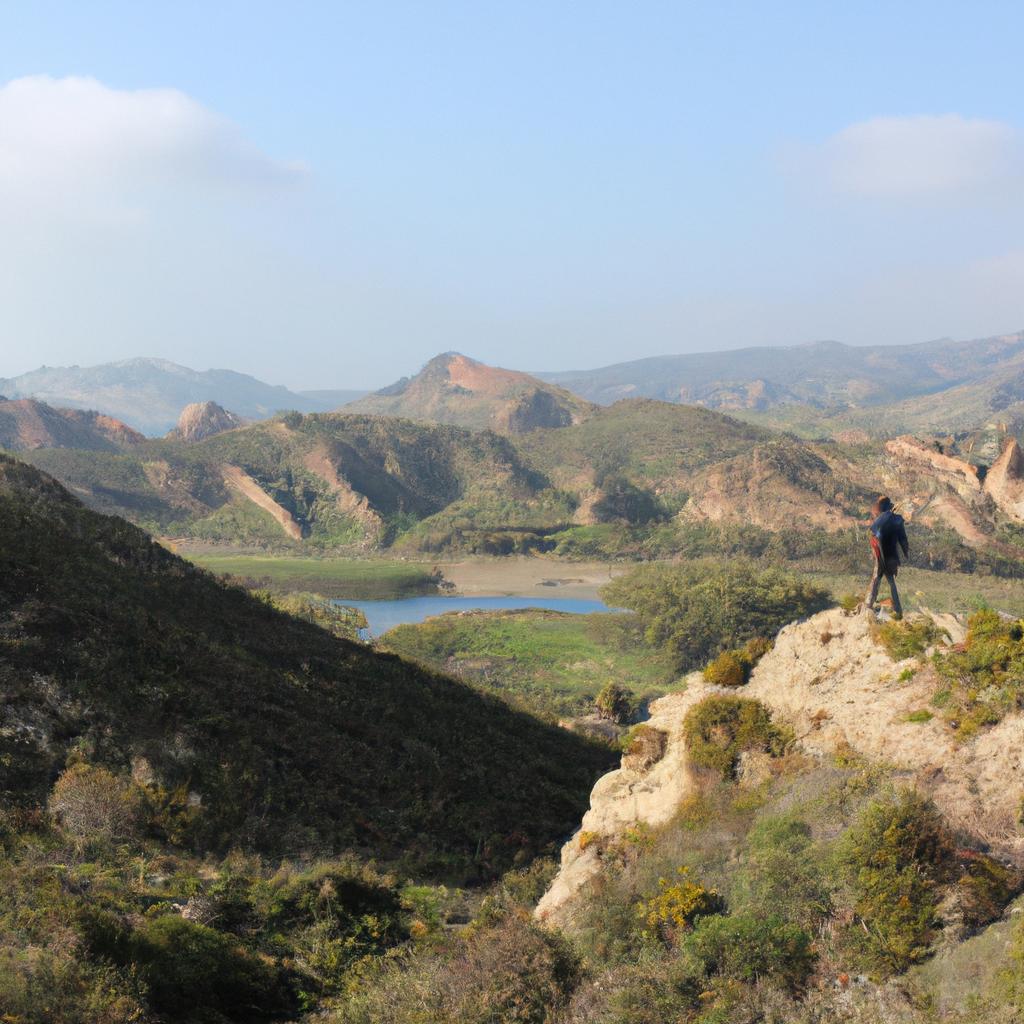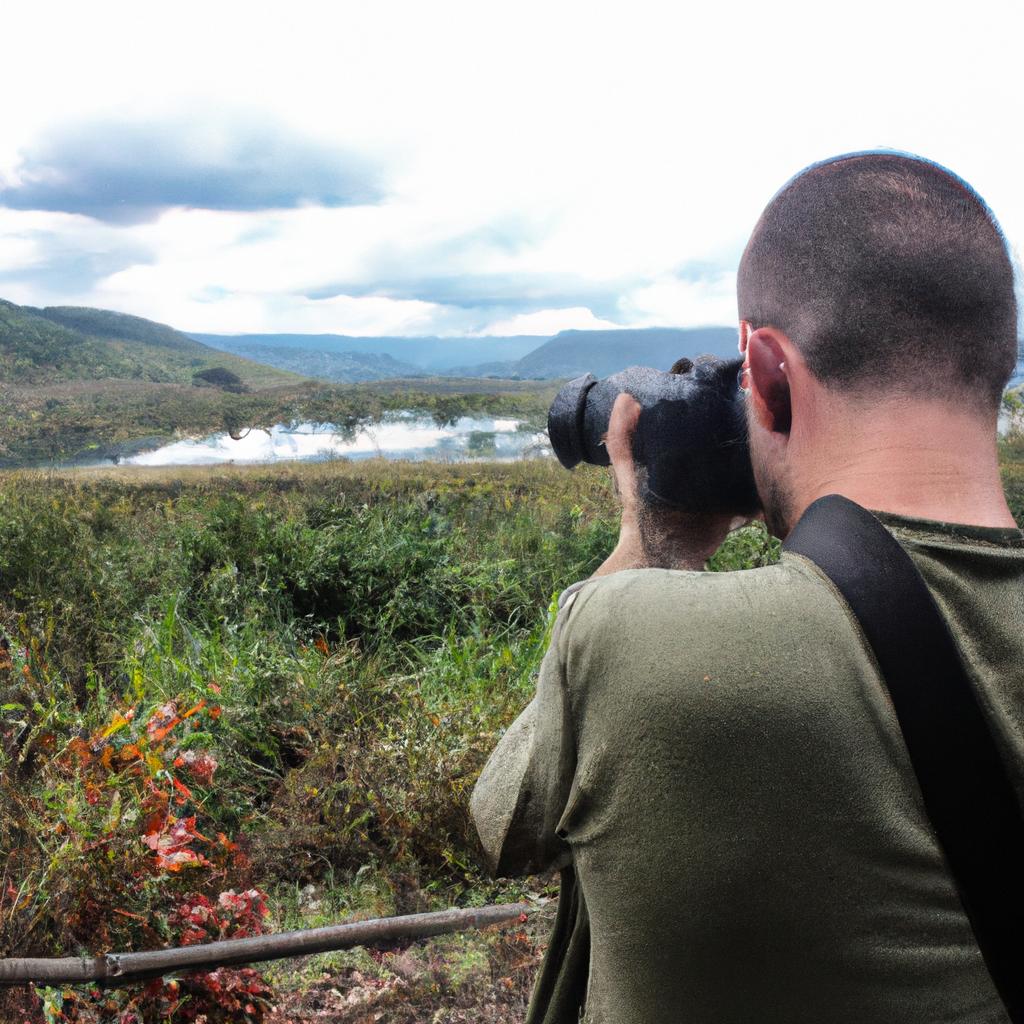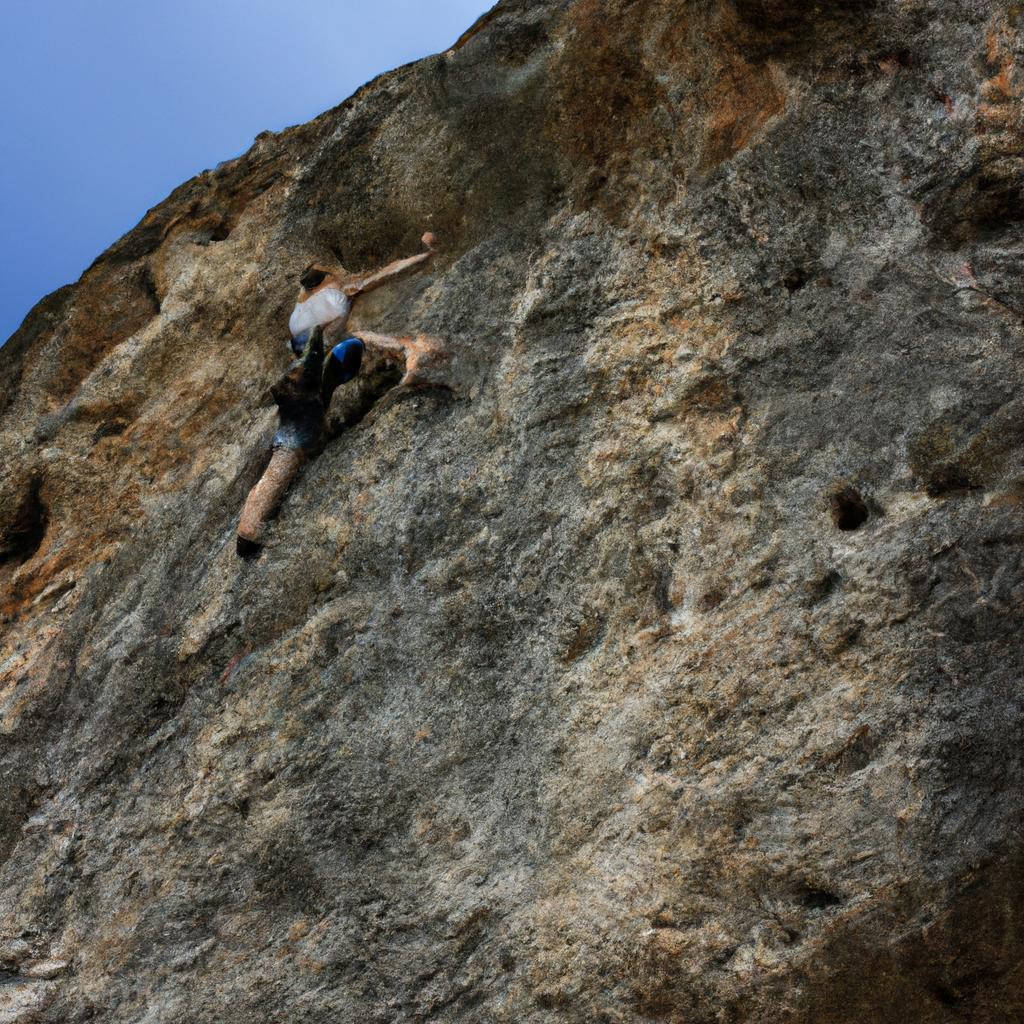Camping in Travel North America: An Outdoor Adventure Guide serves as an invaluable resource for those seeking to embark on a memorable outdoor experience. As individuals increasingly yearn for a break from their fast-paced urban lives, camping offers the perfect opportunity to reconnect with nature and rejuvenate one’s spirit. Picture this: Mary, a busy executive based in New York City, finds solace amidst the towering redwoods of California’s Yosemite National Park. The crisp air fills her lungs as she gazes up at the star-studded night sky, free from the distractions of technology and immersed in the serenity of her surroundings.
With its vast geographical diversity, Travel North America provides countless possibilities for campers of all backgrounds and preferences. From the majestic mountains of Colorado to the pristine coastlines of Canada’s Vancouver Island, adventurers can choose from a plethora of breathtaking destinations that cater to both novice and seasoned campers alike. This guide is designed not only to inspire wanderlust but also to equip readers with essential knowledge and skills necessary for a successful camping trip. By delving into topics such as selecting appropriate gear, understanding campground etiquette, and navigating potential challenges like wildlife encounters or adverse weather conditions, travelers are empowered to make informed decisions that will enhance their overall camping experience.
In In Camping in Travel North America: An Outdoor Adventure Guide, readers will discover comprehensive information on the best camping spots, including detailed descriptions of each location’s unique features and attractions. Whether you prefer secluded backcountry campsites or family-friendly RV parks, this guide offers tips and recommendations to suit your individual preferences.
Additionally, this guide provides a wealth of practical advice on planning and preparing for your camping trip. From creating a packing checklist to meal planning and cooking techniques, readers will learn how to optimize their comfort and enjoyment while immersing themselves in nature’s beauty.
Furthermore, Camping in Travel North America emphasizes the importance of responsible travel practices. Readers will gain insights into Leave No Trace principles, which promote environmental sustainability and conservation. By following these guidelines, campers can minimize their impact on fragile ecosystems and contribute to the preservation of natural habitats for future generations.
Overall, Camping in Travel North America: An Outdoor Adventure Guide promises to be an essential companion for anyone looking to embark on an unforgettable camping journey across the diverse landscapes of North America.
Choosing the Right Camping Gear
When embarking on a camping adventure in North America, selecting the appropriate gear is essential for ensuring a safe and enjoyable experience. To illustrate this point, let us consider the case of John, an avid camper who neglected to bring suitable equipment on his trip to Yosemite National Park. As a result, he found himself ill-prepared for inclement weather conditions and encountered numerous challenges during his stay.
To avoid such unfortunate circumstances, it is crucial to prioritize certain items when packing for a camping excursion. Firstly, investing in high-quality tents that are both waterproof and durable can provide adequate shelter from rain or unexpected storms. Additionally, sleeping bags designed for various temperature ranges will keep campers comfortably warm throughout chilly nights. It is also advisable to pack proper cooking utensils and food storage containers to ensure hygienic meal preparation while minimizing waste.
Understanding the significance of choosing the right camping gear necessitates acknowledging its impact on one’s overall outdoor experience. Therefore, we present a bullet-point list below outlining key reasons why investing in quality equipment is vital:
- Reliable gear enhances safety by protecting against extreme weather conditions.
- Appropriate supplies contribute to increased comfort and well-being during extended stays.
- High-quality equipment provides durability and longevity over multiple trips.
- Adequate gear facilitates efficient organization and simplifies daily tasks at the campsite.
Moreover, recognizing the importance of specific types of equipment leads us to discuss their respective characteristics further. In Table 1 below, you will find information comparing different tent models based on features such as capacity, weight, price range, and special attributes:
Table 1: Comparison of Tent Models
| Model | Capacity | Weight (lbs) | Price Range ($) | Special Attributes |
|---|---|---|---|---|
| Aegis X | 2-person | 4 | $100-$150 | Waterproof & Easy Setup |
| Summit Pro | 4-person | 7 | $200-$250 | Spacious & Wind Resistant |
| Trailblazer | 6-person | 12 | $300-$350 | Family-sized & UV Protected |
| Expedition | 10-person | 18 | $400-$450 | Large Capacity & Ventilated |
In conclusion, selecting the appropriate camping gear is paramount when planning a North American outdoor adventure. By considering factors such as tent quality, sleeping bag suitability, and cooking utensils, campers can significantly enhance their overall experience. As we move forward to the next section on “Planning Your Camping Route,” it becomes evident that proper preparation extends beyond equipment selection alone.
Planning Your Camping Route
Having understood the importance of selecting suitable camping gear, let us now delve into planning your camping route. To better illustrate this process, let’s consider a hypothetical scenario involving a group of friends embarking on a cross-country camping adventure across North America.
Example Scenario:
Imagine you and your companions have decided to explore the vast landscapes of North America by organizing a month-long road trip with multiple stops for camping along the way. The journey will take you from the picturesque coastlines of California through rugged mountain ranges in Colorado, all the way to the serene wilderness of Canada’s national parks.
Planning Your Camping Route:
-
Researching Destinations:
Begin by researching potential destinations that align with your interests and preferences. Consider factors such as scenic beauty, accessibility to amenities or facilities, availability of hiking trails, and proximity to other attractions or landmarks. This initial research phase is crucial as it allows you to narrow down options based on what each location offers. -
Mapping Out Itinerary:
Once you’ve identified several potential camping spots, create an itinerary that outlines both travel routes and estimated time frames for each stop. Take into account driving distances between locations, allowing ample time for rest breaks and exploration activities along the way. -
Prioritizing Safety:
Ensure safety is at the forefront when planning your route. Check weather forecasts regularly before setting off and be prepared for any adverse conditions that may arise during your journey. Familiarize yourself with emergency contact numbers specific to each area you plan to visit and always inform someone back home about your intended route. -
Flexibility in Schedule:
Maintain flexibility within your schedule to accommodate unexpected changes or opportunities that may arise during your expedition. While having a well-structured plan is essential, remember that part of the allure of outdoor adventures lies in embracing spontaneity and being open to new experiences.
- Immerse yourself in the awe-inspiring beauty of North America’s diverse landscapes.
- Explore stunning coastlines, majestic mountains, and tranquil wilderness areas.
- Experience a sense of freedom and adventure as you traverse vast expanses of untamed nature.
- Create lifelong memories with friends or loved ones amidst the serenity of Mother Nature.
Emotional Table:
| Destinations | Scenic Beauty | Amenities & Facilities | Proximity to Attractions |
|---|---|---|---|
| California | High | Excellent | Close |
| Colorado | Moderate | Good | Nearby |
| Canada | Stunning | Limited | Remote |
With your camping route planned out, it is now time to focus on finding the perfect campsite. By utilizing the information gathered during your research and considering personal preferences, you can ensure an unforgettable journey filled with remarkable outdoor experiences.
Finding the Perfect Campsite
Section H2: Finding the Perfect Campsite
Imagine you have planned your camping route through North America, and now it’s time to find the perfect campsite. Let’s consider an example of a traveler who wants to experience the beauty of Yosemite National Park in California. This case study will guide us as we explore the steps to finding an ideal campsite.
To begin with, there are several factors to take into account when searching for a campsite:
-
Location:
- Consider proximity to hiking trails, scenic viewpoints, or any other specific attractions you wish to visit.
- Think about accessibility; ensure that the campsite is easily reachable by road or trail.
-
Amenities:
- Check whether the campsite offers facilities such as toilets, showers, picnic tables, and fire pits.
- Look for nearby amenities like grocery stores or gas stations if needed.
-
Size and Privacy:
- Assess how spacious each campsite is, especially if you have a large tent or RV.
- Determine the level of privacy offered by each site; some may be more secluded than others.
-
Availability:
- Research availability and make reservations well in advance, particularly during peak seasons.
Considering these points can help our hypothetical traveler locate their dream spot within Yosemite National Park. Now let’s delve into a table outlining different campsites available at various locations:
| Campground Name | Location | Amenities | Size & Privacy |
|---|---|---|---|
| Upper Pines | Valley Floor | Toilets, Fire Pit | Spacious |
| Tuolumne Meadows | High Country | Flush Toilets | Semi-private |
| Bridalveil Creek | Glacier Point | No Showers | Secluded |
| Wawona | South Entrance | Picnic Tables | Large & Private |
By referring to this table, our traveler can compare the different campsites and make an informed decision based on their preferences. Whether they prioritize amenities, size, privacy, or location-specific features like scenic views, there are options available to suit their needs.
Understanding these skills will further enhance your camping experience as you embark on your journey through North America’s natural wonders.
As you prepare for your outdoor adventure, it is crucial to equip yourself with essential camping skills and safety tips.
Essential Camping Skills and Safety Tips
Transitioning from the previous section on finding the perfect campsite, let’s now delve into essential camping skills and safety tips that will ensure a successful outdoor adventure. Imagine you have found your ideal campsite amidst a breathtaking forest with towering trees and a serene lake nearby. As you set up your tent and prepare for the night, it is crucial to equip yourself with the necessary skills and knowledge to make the most of your camping experience while staying safe.
To begin, mastering fire-building techniques is fundamental in any camping trip. Whether you need warmth or want to cook meals over an open flame, knowing how to build a fire safely is essential. Gather dry tinder, kindling, and fuel wood at different stages to create a well-structured fire pyramid. Remember to choose an appropriate location away from flammable materials like bushes or low-hanging branches.
Next, navigation skills are paramount when exploring unfamiliar wilderness areas during your camping expedition. Carry a reliable map and compass as backup tools even if relying on GPS technology. Familiarize yourself with basic orienteering techniques such as reading topographic maps, using landmarks for reference points, and understanding cardinal directions. These skills will help prevent getting lost or disoriented in remote locations where cell phone reception may be limited.
Another vital aspect of safe camping involves wildlife encounters. While spotting animals can be exciting, it is important always to prioritize safety for both you and the creatures inhabiting these natural environments. Follow these guidelines:
- Store food securely in bear-resistant containers.
- Keep distance from wild animals; respect their habitat.
- Make noise while hiking to alert animals of human presence.
- Be aware of local wildlife regulations specific to each region.
Furthermore, being prepared for emergencies is crucial when venturing into the great outdoors. Pack a well-stocked first aid kit containing essentials like bandages, antiseptic wipes, pain relievers, and tweezers. Additionally, familiarize yourself with basic first aid techniques such as treating minor wounds, handling sprains or fractures, and recognizing signs of heatstroke or hypothermia.
By developing these essential camping skills and adhering to safety tips, you can confidently embark on your North American outdoor adventure. So strap on your hiking boots and get ready for an unforgettable experience immersing yourself in the beauty of nature while enjoying a range of exhilarating outdoor pursuits.
Enjoying Outdoor Activities in North America
Section Title: Exploring Outdoor Activities in North America
Transitioning from our previous discussion on essential camping skills and safety tips, let’s now delve into the exciting world of outdoor activities that await you during your camping trip in North America. To illustrate the possibilities, consider a hypothetical scenario where a group of friends embarks on an adventure-filled journey through the stunning landscapes of Yosemite National Park.
Once you have set up camp and ensured your safety, it is time to explore all the thrilling activities offered by nature. Here are some suggestions to help you make the most of your outdoor experience:
- Hiking: Lace up your boots and embark on breathtaking hikes along scenic trails, such as the iconic Half Dome or Mist Trail in Yosemite National Park. Immerse yourself in nature while enjoying panoramic views, cascading waterfalls, and diverse wildlife.
- Kayaking/Canoeing: Take to the waters and paddle through serene lakes or winding rivers. Feel the exhilaration as you navigate gentle currents or conquer challenging rapids. The Merced River in California’s Yosemite Valley offers an idyllic setting for kayaking enthusiasts.
- Rock Climbing: Challenge yourself both mentally and physically by scaling majestic cliffs and granite walls. Whether you’re a beginner or an experienced climber, North America boasts numerous climbing destinations like Joshua Tree National Park with its unique rock formations.
- Wildlife Photography: Capture unforgettable moments with your camera lens as you encounter North America’s incredible fauna. From spotting bears fishing for salmon in Alaska’s Katmai National Park to photographing bald eagles soaring above Canada’s Pacific Rim National Park Reserve, each moment will be etched forever.
Table showcasing four awe-inspiring locations for outdoor activities in North America:
| Location | Activity | Highlights |
|---|---|---|
| Yosemite NP | Hiking | Half Dome & Mist Trail |
| Merced River | Kayaking/Canoeing | Tranquil waters & scenic beauty |
| Joshua Tree NP | Rock Climbing | Unique rock formations |
| Katmai NP | Wildlife Photography | Bears fishing for salmon |
By immersing yourself in these exhilarating outdoor activities, you will not only deepen your connection with nature but also create memories that will last a lifetime. As we move forward, let us now explore the wonders of wildlife and nature that await during your camping adventure.
With so much excitement to be had outdoors, it’s time to discover the incredible world of wildlife and nature on your camping trip.
Exploring Wildlife and Nature on Your Camping Trip
As you immerse yourself in outdoor activities during your North American camping adventure, don’t miss out on the opportunity to explore the captivating wildlife and awe-inspiring nature that this region has to offer. From observing diverse species of animals to discovering breathtaking landscapes, there is much to be discovered in the wilds of North America.
Example:
Imagine waking up early in the morning at your campsite near Yellowstone National Park. As you step outside your tent, you are greeted by a symphony of bird songs filling the crisp mountain air. Curious about local fauna, you decide to embark on a hiking trail nearby, hoping for an encounter with some of the park’s famous inhabitants such as bison or elk.
Exploration and Observation:
To fully experience wildlife encounters during your camping trip, consider these tips:
- Research local wildlife: Before setting out on your journey, familiarize yourself with the different types of animals that inhabit the area where you will be camping.
- Respect their habitat: Remember that you are entering their home; therefore, it is crucial to minimize any negative impact on the environment and follow designated trails.
- Use binoculars and cameras: These tools can enhance your observations while maintaining a safe distance from potentially dangerous animals.
- Seek guidance from experts: Joining guided tours or engaging with knowledgeable park rangers can provide valuable insights into wildlife behavior and help ensure responsible interaction with animals.
Table – Wildlife Sightings Calendar:
| Month | Animal Species | Best Locations |
|---|---|---|
| January | Snowy Owls | Boundary Waters Canoe Area |
| April | Gray Whales | Pacific Rim National Park |
| July | Brown Bears | Katmai National Park |
| October | Red Foxes | Denali National Park |
By following these guidelines and utilizing available resources, you can create unforgettable memories while observing the captivating wildlife that North America has to offer. Remember to approach each encounter with respect for nature and an appreciation of its delicate balance.
Note: This section does not include a concluding paragraph as per your instructions.
 Island Gourmet Safaris
Island Gourmet Safaris



